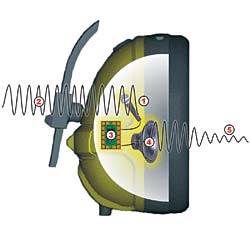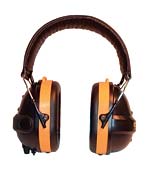Active Noise Reduction
This technology promises to solve noise problems that passive protectors cannot solve.
- By Joanna Lipper
- Jun 05, 2007
DURING the past half century, technology
has improved virtually every
aspect of human life. However,
during this period, not much has changed
in the world of personal protective equipment.
For hearing safety, workers may
choose either ear plugs that are inserted
into the ear or ear muffs that cover the ears.
These are called passive ear defenders
because they employ acoustic foam to
block noise waves from entering the ear.
Passive protection is very effective against
mid- and high-frequency noise, but low-frequency
noise generated by engines,
motors, and fans is more challenging. Low-frequency
noise waves, prevalent in many
industrial environments, are longer, can
travel great distances, and can penetrate
passive barriers, even cement walls.
Active Noise Reduction (ANR) is the
only effective method of attenuating low-requency
noise. This technology is also
commonly termed Electronic Noise Cancellation
(ENC), Active Noise Cancellation
(ANC), or “anti-noise.” ANR is
achieved by electronically coupling a noise
wave with its exact mirror image, thereby
canceling the noise. Figure 1 shows the
relationship in time of a noise signal, an
anti-noise signal, and the residual noise
that results when they meet.
 Figure 1
Figure 1
The benefits of ANR have been well
understood by the military and aviation
markets for many years. Aircraft cabin
noise, for example, is well within the
effective range of ANR, and therefore
most aviation headsets incorporate the
technology. The price of communications
headsets incorporating ANR can be as
high as $1,200.
The consumer audio market has also
embraced the technology during the past
10 years, with every major audio manufacturer
offering noise-canceling headphones
for use on airplanes and in other low-frequency
noise environments where consumers
are using portable audio devices.
These noise-canceling headphones range
in price from $39 to $299 and have varying
levels of performance.
Although the technology is commonplace
in the aviation, military, and consumer
worlds, ANR has not been widely
available to the industrial worker. This is
now beginning to change with cost-effective
ANR ear muffs, priced in the $149
range, that are self-contained, conveniently
powered, and relatively lightweight.
The Technology’s Evolution
Electronic noise reduction technology is
not a new idea. The concept of creating a
copy of a sound and using that copy to
cancel the original sound dates back to
the early 1900s. These first electronic
noise cancellation systems used a simple
“delay and invert” approach that was limited
in its effectiveness. In the mid-
1970s, rapid advancement of ANR systems
was achieved with the use of
adaptive filters to generate the antinoise.
This allowed the systems to adapt
continuously to changes in their external
world and in their own components.
A second breakthrough in the mid-
1970s was the recognition that many
noises, particularly those produced by
man-made machines, are periodic or tonal.
This tonal noise allowed for a more effective
solution because each repetition created
a predictable harmonic pattern, which
enabled the electronic system to generate a
more accurate anti-noise signal.
As was previously mentioned, by the
early 1990s, the technology was commonly
seen in aviation and the military; by the
mid-1990s, consumer noise canceling
audio headphones were a widely known
and well-understood product category.
Low-frequency Noise
Low-frequency noise from engines,
motors, and fans can dominate many
industrial settings, yet this component of
the noise spectrum is largely unaddressed
by passive hearing protection. Some of the
loudest low-frequency environments and
equipment include airfields, forestry, payloaders,
diesel locomotives, forges, factories,
highways, ship engine rooms, and
heavy tractors.
In addition to hearing loss, prolonged
exposure to noise, including low-frequency
noise, is known to cause many detrimental
psychological and physiological effects,
including fatigue, anxiety, depression, loss
of concentration, reduced productivity,
headaches, and high blood pressure. Low-frequency
noise is also particularly detrimental
to communication because it masks
consonant sounds—the sounds that make
speech intelligible.
In most environments, there is noise in
a wide frequency range. As previously discussed,
most currently available hearing
protection products are passive devices
intended to prevent noise from entering the
ear, making them effective against the mid
and high frequencies but ineffective against
the low frequencies. Aside from the fact that
passive hearing protection does not address
the full range of noise frequencies, the measure
of effectiveness for these devices, the
Noise Reduction Rating (NRR), cannot be
taken at face value. The hearing protection
level is often degraded because of improper
insertion of ear plugs and wear and tear on
the clamping force and ear seals of ear
muffs. The most complete hearing protection
currently available to workers is a device that combines ANR and passive
noise control methods. Figure 2 shows a
cross section of an ANR ear muff.  Figure 2
Figure 2
This type of ear muff uses a microphone
inside the ear cup (1) to listen to
noise coming into the ear (2). Using electronics
(3), the system takes that information
and uses it to create a noise wave that
is identical to, but directly opposite of, the
one coming into the ear. The “anti-noise”
wave is output through a speaker (4), also
located in the ear cup. When the two waves
(the noise wave and the anti-noise wave)
meet, the noise is significantly reduced (5).
Figure 3 is a photograph of an ANR ear
muff. As you can see, the outer appearance
of an ANR ear muff is virtually identical to
that of a standard passive ear muff; however,
ANR ear muffs deliver 20dB of electronic
noise cancellation within the 20-800
Hz range. For the most complete hearing
protection, these ear muffs also deliver a
passive NRR of as high as 26. Additionally,
these ear muffs feature an audio input so
workers who are allowed to listen to music
on the job can listen at safe volume levels.
 Figure 3
Figure 3
Conclusion
ANR is the next technological breakthrough
in industrial hearing protection
because it remedies the noise problems
that previously had no solution. There
have been no significant advances in passive
hearing protection, because passive is
well understood and has been fully
exploited. The only opportunity to provide
workers with the next generation in
hearing protection will be through electronic
means such as ANR.
Currently available ANR ear muffs provide
a greater level of hearing protection at
a reasonable cost. As hearing loss continues
to be a problem and noise standards
become more stringent, we expect
advanced hearing protection will be more
widely adopted and even required in
certain noise environments.
This article originally appeared in the June 2007 issue of Occupational Health & Safety.